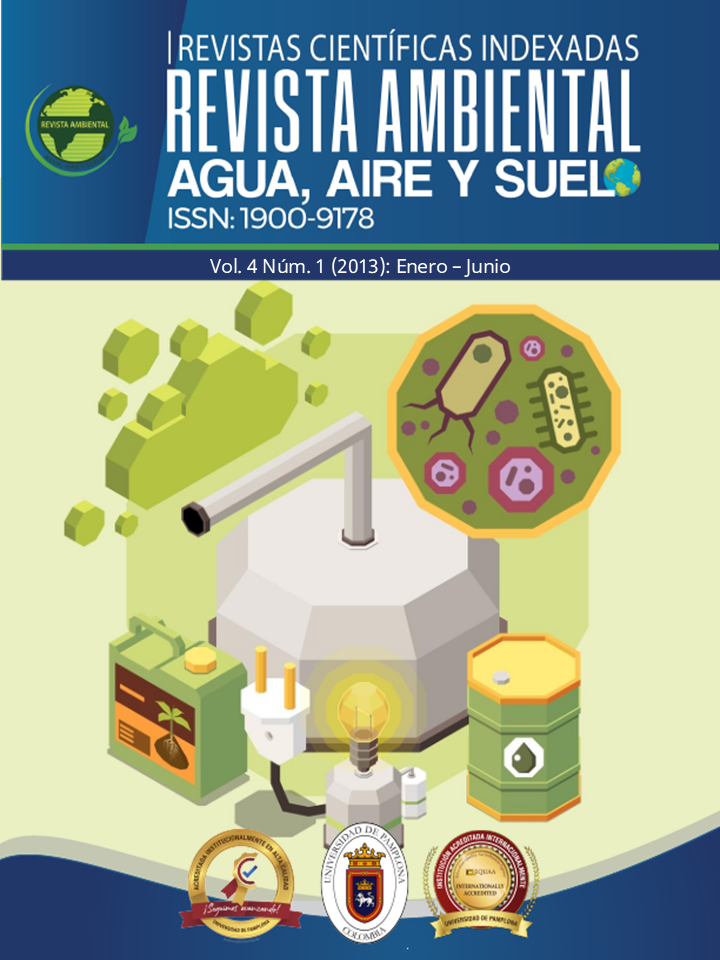Determination of biogenic volatile organic compounds in a rural atmosphere (Valdejero Natural Park)
DOI:
https://doi.org/10.24054/aaas.v4i1.2012Keywords:
COV, monoterpenes, identification, response factor, eventsAbstract
Knowledge about the composition of volatile organic compounds in rural areas is minimal compared to urban or industrial areas. Determining this composition is a topical issue, given the high potential emission of biogenic compounds and the scarcity of local sources of anthropogenic compounds in these areas, many of which are toxic and carcinogenic.
Paraffins are the main compounds in this environment, followed by olefins, with more than 30 compounds having minimum and average values below the detection limit of the analytical equipment, which is characteristic of an area with low anthropogenic activity.
Paraffins are the most abundant compounds in this environment, followed by olefins, with more than 30 compounds showing minimum and average values below the detection limit of the analytical equipment, which is characteristic of a rural background area. During this period, concentrations of anthropogenic compounds have decreased due to the decline in industrial activity in the surrounding area.
However, certain incidents with slightly higher than usual concentrations reflect the importance of local traffic, human intervention, and atmospheric transport phenomena such as polluted air masses.
The concentrations of biogenic organic compounds have remained constant over the years, with monoterpenes being the most abundant in Valderejo during the summer (May-August). Monoterpenes elute in three chromatographic signals, which originate from their reaction to high temperatures within the system. Correct identification was carried out with the support of a GC-MS gas chromatograph with mass spectrophotometer, installed at the ETSI in Bilbao, using the mass spectrum and retention index of each individual compound as tools.
individual.
Downloads
References
Arnts, R., 2010. Evaluation of absorbent samplingtube materials and Tenax-TA for analysis of volatile biogenic organic compounds. Atmospheric Environment 44, 1579-1584.
Atkinson, R., 2000. Atmospheric chemistry of VOCs and NOx. Atmospheric Environment 34, 2063-2101.
Atkinson, R., Arey, J., 2003. Gas-phase tropospheric chemistry of biogenic volatile organic compounds: a review. Atmospheric Environment 37 Supplement No. 2, S197-S219.
Babushok, V.I., Linstrom, P.J., Reed, J.J., Zenkevich, I.G., Brown, R.L., Mallard, W.G., Stein, S.E., 2007.
Development of a database of gas chromatographic retention properties of organic Journal of Chromatography A 1157, 414-421.
Badol, C., Borbon, A., Locoge, N., Léonardis, T., Galloo, J.C., 2004. An automated monitoring system for VOC ozone precursors in ambient air: development, implementation and data analysis. Analytical & Bioanalytical Chemistry 378, 1815 –1824.
Borbon, A., Coddeville, P., Locoge, N., Galloo, J., 2004. Characterising sources and sinks of rural VOC in Eastern France. Chemosphere 57, 931 – 942.
Burns. W.F., Tingey, D.T., Evans, R.C., Bates, E.H., 1983. Problems with a Naftion membrane dryer for drying chromatographic samples. Journal of Chromatography 269, 1 - 9.
Calfapietra; C., Fares, S., Loreto, F., 2009. Volatile organic compounds from Italian vegetation and their interaction with ozone. Environmental Pollution 157, 1278 – 1486.
Cerqueira, M.A., Pio, C.A., Gomes, P.A., Matos, J.S., Nunes, T.V., 2003. Volatile organic compounds in
rural atmospheres of central Portugal. The Science of the Total Environment 313, 49 – 60. Chang, C., Wang, J., Liu; S., Lung, S.C., 2006.
Assessment of vehicular and non-vehicular contributions to hydrocarbons using exclusive vehicular indicators. Atmospheric Environment 40, 6349 – 6361.
Decreto 4/1992, de 14 de enero, por el que se declara Parque Natural el área de Valderejo. Boletin oficial del País Vasco. Gobierno Vasco. http://www.euskadi.net/bopv2/datos/1992/02/9200397a.pdf
Derwent, R.G., Davies, T.J., Delaney, M., Dollard, G.J., Field, R.A., Dumitrean, P., Nason, P.D., Jones, B.M.R., Pepler, S.A., 2000. Analysis and interpretation of the continuous hourly monitoring data for C2 – C8 hydrocarbons at 12 United Kingdom sites during 1996.
Atmospheric Environment 34, 297-312. Durana, N., Navazo, M., Gémez, M.C., Alonso, L., García, J.A., Ilardia, J.L., Gangoiti, G., Iza, J., 2006.
Long term hourly measurement of 62 non-methane hydrocarbons in an urban area: Main results and contribution of non-traffic sources. Atmospheric Environment 40, 2860 – 2872.
Evtyugina, M.G., Nunes, T., Alves, C., Marques, M.C., 2009. Photochemical pollution in rural mountainous
area in the northeast of Portugal. Atmospheric Research 92, 151 – 158.
Friedrich, R., 2009. Natural and biogenic emissions of environmentally relevant atmospheric trace constituents in Europe. Atmospheric Environment 43, 1377 – 1379.
Gómez, M.C., Durana, N., Navazo, M., Alonso, L.,
García, J.A., Ilardia, J.L., 2004. Application of validation data tests from an on-line volatile organic compound analyser to the detection of air pollution episodes in urban areas. Analytica Chimica Acta 524, 41 – 49.
Helming, D., 1999. Air analysis by gas chromatography. Journal of chromatography A 843, 129 – 146.
Downloads
Published
Issue
Section
License
Copyright (c) 2022 REVISTA AMBIENTAL AGUA, AIRE Y SUELO

This work is licensed under a Creative Commons Attribution-NonCommercial 4.0 International License.










